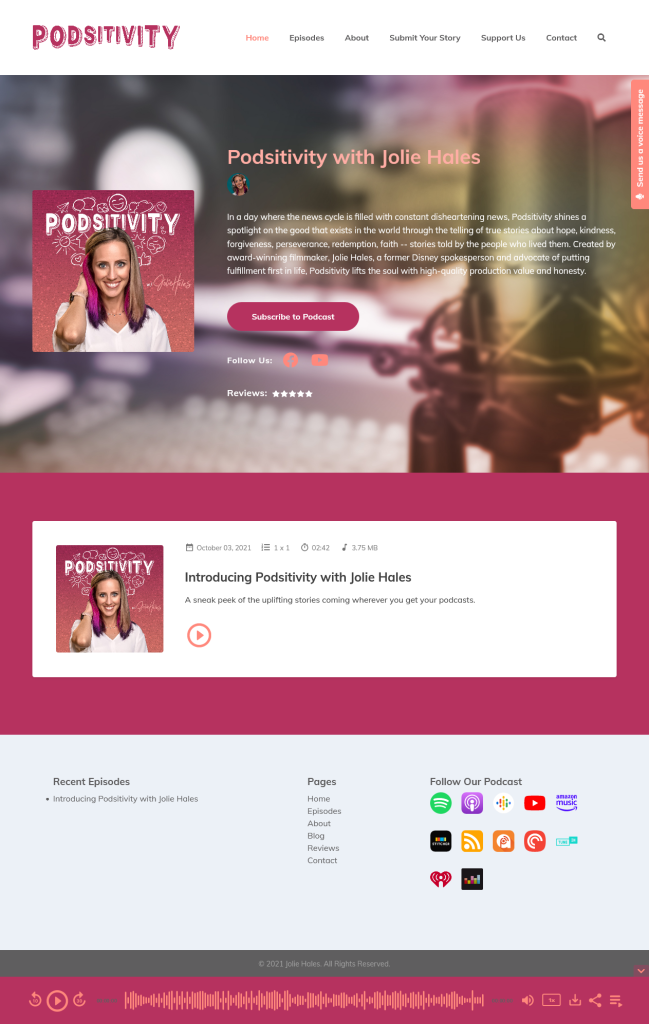So you’ve created an amazing show, but now comes the hard part: how do you grow your podcast audience? After spending weeks pouring your heart and soul into creating countless episodes, it’d be a mistake not to spend a moment to build a loyal fanbase of listeners and grow your podcast audience.
Even if you’re already a well-known podcaster, but your audience numbers aren’t ticking upwards over time, it’s worth an effort. How can you attract more people when your numbers are already pretty decent?
There are many different ways to grow your podcast audience. Here are ten of the best ideas that will help to get more eyes (and ears) tuning into your podcast.
How to grow your podcast audience
1. Create a podcast website
Using podcasting platforms like YouTube or Spotify to host your content is a good idea, but nothing beats having your own podcast website. This is one of the best ways to get organic traffic while also benefiting from search engine optimization (SEO).
Look at your podcast website as a sales funnel. When creating a podcast website, focus on optimizing user experience.
You want to avoid getting new people on your site, only for them to bounce off after a matter of seconds. Ideally, you want new visitors to subscribe and stick around to watch your content.
When developing your website, ensure that it’s responsive and mobile-friendly. Studies have found that a majority of podcast consumption (65%) happens on a mobile device. Take a mobile-first approach so that your website functions on all screen sizes. If you use Podcastpage to create a podcast website, it comes with a mobile-friendly design, so you don’t need to worry about it.
Your website is not only a growth engine, but it can benefit your existing audience by offering them more types of content, a direct channel to contact you or leave a voice message, read reviews about your show, and so much more.

2. Engage with your audience
Sometimes the most obvious solutions are the ones that podcasters forget all about. Your audience loves listening to your content, but what they love even more is engagement. Set aside 15 minutes of each of your episodes to engage with your audience.
Have a conversation. Ask and answer questions. Respond to comments on social media. There are endless ways to get your audience involved. You can also add a way for the users to leave voice messages on your podcast website, so not only will you actually get a view to what they think, you might even want to incorporate it in your episode.
You’ll quickly find that by engaging with your audience, they feel less like consumers and more like friends. Creating a connection with your audience makes them even more dedicated to you and your brand.
Go to where your audience is hanging out online and try to find ways to bring in some of them to listen to your show. This can be online forums, social networks, YouTube, Twitch, Slack and so many other options.
3. Take feedback to heart
While some listeners will provide feedback just to speak their mind, many do so in hopes of helping you improve. Though it can be tough to hear criticism, instead of taking it negatively, use it constructively. Don’t wait for them to reach out, try to ask for feedback proactively.
Listen to what your audience is saying and find ways to incorporate their feedback. Even the simplest changes, like having a simpler background or upgrading your mic to provide crisp quality can have a huge impact.
By incorporating feedback, your audience will feel respected and heard.

4. Create podcast transcripts
Creating podcast transcripts does take some extra time and effort, but the benefits are well worth it. Podcast transcripts benefit you and your audience. Because transcripts are text-based content, they play a large role in SEO by improving your search results.
Podcast transcriptions are also beneficial in that they make your content more accessible. They allow people who have partial or total hearing loss to benefit from your message. The more people your content reaches, the more successful you’ll be.
There are many ways to transcribe your podcasts, including:
- Manual transcription
- Hiring a transcriber
- Using a podcast transcription service (either fully automated based on AI, manual or hybrid.)
Transcripts will set you apart from the crowd while making your content more accessible to a larger number of people. Once you include those on your site, SEO can kick in over time and help you bring organic traffic.
5. Network with other podcasters
The podcasting industry isn’t a dog-eat-dog world. In fact, if you want to succeed, you’ll need to master the art of networking. Despite other areas of the online world being toxic and overly competitive, you’ll quickly find that the podcasting community is anything but.
If you want to get noticed, look at other podcasters as peers versus competitors. The fact is that your audience listens to other shows. There’s plenty of room for your content as well.
So how can you network? Reach out to podcasters through online channels. If you find content that you like, share it and leave a comment. Promote other podcasters or shout them out during an episode.
Networking is one of the best ways to get your content in front of new people, learn from successful podcasters, or get a shoutout on other podcasts.
6. Be a guest
As you start to make connections within the podcasting community, be willing to serve as a guest on someone else’s podcast. By linking up with other relevant podcasters, you’re able to get in front of a totally new audience.
When pitching yourself as a guest, don’t make it strictly promotional. No one’s audience wants to listen to content about why your content is so great. As a guest, you need to be an asset, not a deterrent.
Talk about your expertise. Be a unique voice and keep it interesting. Find ways to pique their interest so that they’re interested in tuning into your content as well.
7. Use social media to your advantage
Social media platforms have billions of daily active users. By sharing your content on these networks, you’re more likely to reach new people. There are all sorts of ways that you can use social media to market your podcasts, including:
- Creating and posting short, catchy soundbite clips
- Posting teasers for upcoming episodes
- Using Canva to create quote images
- Letting people go behind-the-scenes using videos or stories
Don’t try to use all of the social media platforms at once. Figure out where your audience is hanging out, which platforms they mostly use, and share their first. Additionally, each platform will require some format changes, so make sure to post the right format on the right platform. (Think about the difference between Tik Tok, Instagram, and Pinterest.)

8. Release on a regular schedule
Binge-watching is a thing. You probably know firsthand how easy it is to get sucked into a new show. After finishing the first episode, you’re left extremely upset that the next episode isn’t available until next week.
In growing your audience, be mindful of launch quality. There’s nothing worse than getting someone hooked on an episode, only for them to find little to no other content to enjoy.
When you first launch or start a new series, think about publishing 3-5 episodes. A solid multi-launch strategy is a great way to get more traffic and repeat viewers. Then, try to release new episodes on the same day of the week, and try to do it weekly or bi-weekly to keep your listeners engaged.
9. Submit your content to as many platforms as you can
Podcast aggregators/platforms, also known as podcatchers, are apps that exist to play podcasts. Some of the most well-known podcatchers include Google Play, Apple Podcasts, TuneIn, Spotify, and SoundCloud.
By submitting your content to a podcast aggregator, there’s a greater chance of it being seen by a new audience as they look for new content to consume.
To get started, create an account on the podcatcher platform and then submit your RSS feed. This ensures that all of your new episodes are automatically published to each aggregator.
10. Be strategic about timing
As with most things in life, timing is everything when posting new podcast content. If you’re just starting out in the podcast community, you may not know when to post. Browse similar podcasts and see when they publish. Odds are that you’ll notice a trend.
If similar podcasters all post around the same time, there’s a reason for that. Follow the trend and then start collecting your own data. After a few weeks, you can look through your analytics to see when most of your audience is listening to your content.
Be mindful of timezones, especially if your audience spans across the globe.
Final thoughts – Grow your podcast audience
Podcasting is expected to become even more popular in the future. Now is the perfect time to master the art of growing your audience so that you can be successful in the short- and long-term.
From creating a podcasting website to using social media to engaging with your audience, there are endless ways to get your content in front of new sets of eyes. You don’t have to use all 10 of the above ideas. Find which options work best for you and stick with it!



